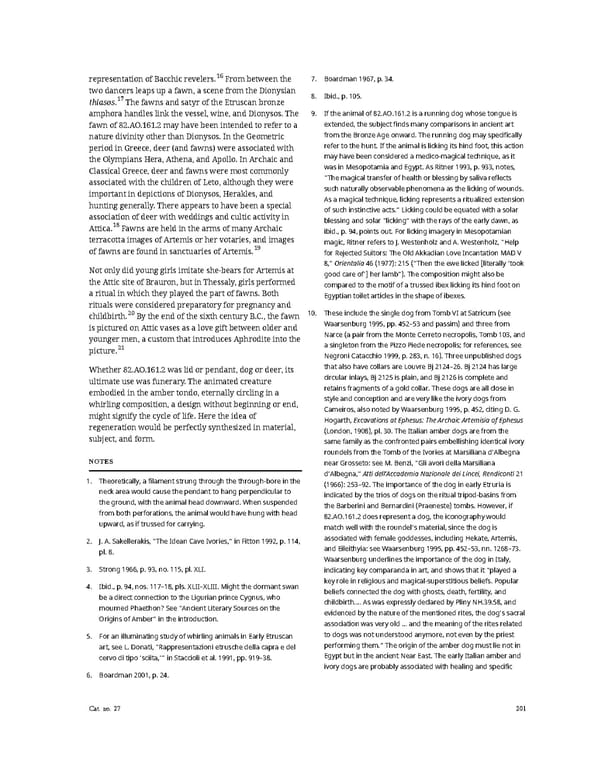representation of Bacchic revelers.16 From between the 7. Boardman 1967, p. 34. two dancers leaps up a fawn, a scene from the Dionysian 8. Ibid., p. 105. thiasos.17 The fawns and satyr of the Etruscan bronze amphora handles link the vessel, wine, and Dionysos. The 9. If the animal of 82.AO.161.2 is a running dog whose tongue is fawn of 82.AO.161.2 may have been intended to refer to a extended, the subject finds many comparisons in ancient art nature divinity other than Dionysos. In the Geometric from the Bronze Age onward. The running dog may specifically period in Greece, deer (and fawns) were associated with refer to the hunt. If the animal is licking its hind foot, this action the Olympians Hera, Athena, and Apollo. In Archaic and may have been considered a medico-magical technique, as it Classical Greece, deer and fawns were most commonly was in Mesopotamia and Egypt. As Ritner 1993, p. 933, notes, associated with the children of Leto, although they were “The magical transfer of health or blessing by saliva reflects important in depictions of Dionysos, Herakles, and such naturally observable phenomena as the licking of wounds. hunting generally. There appears to have been a special As a magical technique, licking represents a ritualized extension association of deer with weddings and cultic activity in of such instinctive acts.” Licking could be equated with a solar Attica.18 Fawns are held in the arms of many Archaic blessing and solar “licking” with the rays of the early dawn, as ibid., p. 94, points out. For licking imagery in Mesopotamian terracotta images of Artemis or her votaries, and images magic, Ritner refers to J. Westenholz and A. Westenholz, “Help of fawns are found in sanctuaries of Artemis.19 for Rejected Suitors: The Old Akkadian Love Incantation MAD V Not only did young girls imitate she-bears for Artemis at 8,” Orientalia 46 (1977): 215 (“Then the ewe licked [literally ‘took the Attic site of Brauron, but in Thessaly, girls performed good care of’] her lamb”). The composition might also be compared to the motif of a trussed ibex licking its hind foot on a ritual in which they played the part of fawns. Both Egyptian toilet articles in the shape of ibexes. rituals were considered preparatory for pregnancy and childbirth.20 By the end of the sixth century B.C., the fawn 10. These include the single dog from Tomb VI at Satricum (see is pictured on Attic vases as a love gift between older and Waarsenburg 1995, pp. 452–53 and passim) and three from younger men, a custom that introduces Aphrodite into the Narce (a pair from the Monte Cerreto necropolis, Tomb 103, and picture.21 a singleton from the Pizzo Piede necropolis; for references, see Negroni Catacchio 1999, p. 283, n. 16). Three unpublished dogs Whether 82.AO.161.2 was lid or pendant, dog or deer, its that also have collars are Louvre Bj 2124–26. Bj 2124 has large ultimate use was funerary. The animated creature circular inlays, Bj 2125 is plain, and Bj 2126 is complete and embodied in the amber tondo, eternally circling in a retains fragments of a gold collar. These dogs are all close in whirling composition, a design without beginning or end, style and conception and are very like the ivory dogs from might signify the cycle of life. Here the idea of Cameiros, also noted by Waarsenburg 1995, p. 452, citing D. G. regeneration would be perfectly synthesized in material, Hogarth, Excavations at Ephesus: The Archaic Artemisia of Ephesus subject, and form. (London, 1908), pl. 30. The Italian amber dogs are from the same family as the confronted pairs embellishing identical ivory roundels from the Tomb of the Ivories at Marsiliana d’Albegna NOTES near Grosseto: see M. Benzi, “Gli avori della Marsiliana d’Albegna,” Atti dell’Accademia Nazionale dei Lincei, Rendiconti 21 1. Theoretically, a filament strung through the through-bore in the (1966): 253–92. The importance of the dog in early Etruria is neck area would cause the pendant to hang perpendicular to indicated by the trios of dogs on the ritual tripod-basins from the ground, with the animal head downward. When suspended the Barberini and Bernardini (Praeneste) tombs. However, if from both perforations, the animal would have hung with head 82.AO.161.2 does represent a dog, the iconography would upward, as if trussed for carrying. match well with the roundel’s material, since the dog is 2. J. A. Sakellerakis, “The Idean Cave Ivories,” in Fitton 1992, p. 114, associated with female goddesses, including Hekate, Artemis, pl. 8. and Eileithyia: see Waarsenburg 1995, pp. 452–53, nn. 1268–73. Waarsenburg underlines the importance of the dog in Italy, 3. Strong 1966, p. 93, no. 115, pl. XLI. indicating key comparanda in art, and shows that it “played a 4. Ibid., p. 94, nos. 117–18, pls. XLII–XLIII. Might the dormant swan key role in religious and magical-superstitious beliefs. Popular be a direct connection to the Ligurian prince Cygnus, who beliefs connected the dog with ghosts, death, fertility, and mourned Phaethon? See “Ancient Literary Sources on the childbirth.… As was expressly declared by Pliny NH.39.58, and Origins of Amber” in the introduction. evidenced by the nature of the mentioned rites, the dog’s sacral association was very old … and the meaning of the rites related 5. For an illuminating study of whirling animals in Early Etruscan to dogs was not understood anymore, not even by the priest art, see L. Donati, “Rappresentazioni etrusche della capra e del performing them.” The origin of the amber dog must lie not in cervo di tipo ‘sciita,’” in Staccioli et al. 1991, pp. 919–38. Egypt but in the ancient Near East. The early Italian amber and ivory dogs are probably associated with healing and specific 6. Boardman 2001, p. 24. Cat. no. 27 201
 Ancient Carved Ambers in the J. Paul Getty Museum Page 210 Page 212
Ancient Carved Ambers in the J. Paul Getty Museum Page 210 Page 212